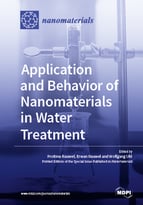Application and Behavior of Nanomaterials in Water Treatment
A special issue of Nanomaterials (ISSN 2079-4991).
Deadline for manuscript submissions: closed (15 April 2019) | Viewed by 57310
Special Issue Editors
Interests: nanoparticles; thin films; carbon-based hybrid materials; photovoltaics; LED; photocatalysis; electron microscopy; water purification
Special Issues, Collections and Topics in MDPI journals
Interests: metal-oxide thin-film deposition; atomic layer deposition; nanomaterial synthesis; metal nanoparticles; metal-oxide nanoparticles; water purification; nanomedicine; photovoltaics; hybrid nanocomposites
Special Issues, Collections and Topics in MDPI journals
Interests: water treatment; environmental systems engineering; water quality; water resources; particle technology
Special Issue Information
Dear Colleagues,
Water is one of the most important resources for human existence. However, the contamination of water resources by heavy metal ions, dyes, and pharmaceuticals appears to be a severe threat, worldwide, and these contaminations, even in very small concentrations, disturb or threaten aquatic ecosystems and biodiversity. They also tend to be carcinogenic and, therefore, are health hazards.
The recent development of nanotechnologies is an important emerging field in water remediation. The last few decades have shown the development of multiple applications involving nanomaterials and, more particularly, metal nanoparticles that are now applied for the decontamination of water. Multiple technologies based on graphene-based nanocomposites, functionalized magnetic nanomaterials, layered double hydroxides, and nanophotocatalysts, have been investigated for the same purpose. Challenges such as the removal of radionuclides, heavy metal cations and metalloids, such as Pb, Cd, Hg, Cr, Cu, Zn, nitrates, phenols, and other organic species, can be met using nanomaterials that enable a selective extraction via functionalization.
This Special Issue will compile recent developments in nanomaterials in the field of water treatment. The topics are open to nanomaterials both organic and inorganic that are used in applications related to water remediation.
Dr. Protima Rauwel
Prof. Dr.-Ing. Wolfgang Uhl
Prof. Dr. habil. Erwan Rauwel
Guest Editors
Manuscript Submission Information
Manuscripts should be submitted online at www.mdpi.com by registering and logging in to this website. Once you are registered, click here to go to the submission form. Manuscripts can be submitted until the deadline. All submissions that pass pre-check are peer-reviewed. Accepted papers will be published continuously in the journal (as soon as accepted) and will be listed together on the special issue website. Research articles, review articles as well as short communications are invited. For planned papers, a title and short abstract (about 100 words) can be sent to the Editorial Office for announcement on this website.
Submitted manuscripts should not have been published previously, nor be under consideration for publication elsewhere (except conference proceedings papers). All manuscripts are thoroughly refereed through a single-blind peer-review process. A guide for authors and other relevant information for submission of manuscripts is available on the Instructions for Authors page. Nanomaterials is an international peer-reviewed open access semimonthly journal published by MDPI.
Please visit the Instructions for Authors page before submitting a manuscript. The Article Processing Charge (APC) for publication in this open access journal is 2900 CHF (Swiss Francs). Submitted papers should be well formatted and use good English. Authors may use MDPI's English editing service prior to publication or during author revisions.
Keywords
- Water treatment
- Waste water, drinking water,
- irrigation water,
- feedstock drinking water,
- industrial water
- Radionuclides
- Heavy metal ions
- Graphene
- carbon nanotubes
- Nanoparticles
- Photocatalysts
- Ion exchange
- Pharmaceuticals
- Dyes









